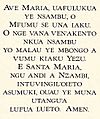Kongo language facts for kids
Quick facts for kids Kongo |
|
|---|---|
| Kikongo | |
| Native to | Democratic Republic of the Congo Republic of the Congo |
| Region | Central Africa |
| Language family |
Niger–Congo
|
Kongo, also known as Kikongo, is an important language spoken in Central Africa. It belongs to the Bantu languages family. Millions of people speak Kongo in countries like the Democratic Republic of the Congo, the Republic of the Congo, and Angola. It is the language of the Kongo and Ndundu communities.
Kongo is a tonal language. This means the meaning of a word can change depending on the pitch of your voice. For example, the same word might mean different things if you say it with a high tone versus a low tone.
Contents
Kongo's Journey to the Americas
Hundreds of years ago, many people who spoke Kongo were brought from Africa to the Americas. They were sold as slaves. Because of this, the Kongo language spread far beyond Africa.
Today, you can still find parts of Kongo in some special traditions and religions in the Americas. These include places like Brazil, Cuba, Puerto Rico, Dominican Republic, and Haiti. The language mixed with others to create new forms.
Kongo's Influence on Other Languages
Kongo also helped shape other languages. For example, it is one of the sources of the Gullah language. Gullah is spoken by some communities in the southeastern United States. It also influenced Palenquero, a unique language spoken in Colombia.
Who Speaks Kongo Today?
Most people who speak Kongo today live in Africa. There are about seven million people who speak Kongo as their first language. Another two million people use it as a second language. This shows how important Kongo remains in Central Africa.
Images for kids
-
The Hail Mary in Kikongo.
See also
 In Spanish: Kikongo para niños
In Spanish: Kikongo para niños


